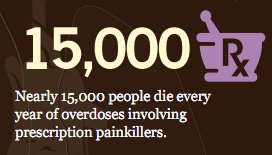 A new form of drug abuse is on the rise. And it isn’t the kind that takes place in dark allies, or street corners, late at night. This new form of drug abuse is prescription painkiller drug abuse and it includes painkillers commonly known as opioids or narcotic pain relievers such as Vicodin (hydrocodone), OxyContin (oxycodone), Opana (oxymorphone) and methadone.
A new form of drug abuse is on the rise. And it isn’t the kind that takes place in dark allies, or street corners, late at night. This new form of drug abuse is prescription painkiller drug abuse and it includes painkillers commonly known as opioids or narcotic pain relievers such as Vicodin (hydrocodone), OxyContin (oxycodone), Opana (oxymorphone) and methadone.
“Overdoses involving prescription painkillers are at epidemic levels and now kill more Americans than heroin and cocaine combined.” CDC Director Thomas Frieden, M.D., M.P.H.
To gain a better understanding of how this type of overdose occurs; let’s take a look at what causes prescription painkiller deaths. Prescription painkillers bind to receptors in the brain, decreasing a person’s perception of pain and creating a feeling of euphoria. Many people find themselves becoming physically dependent and addicted to these prescription painkillers.
Problems arise once the body becomes dependent on painkillers. The body no longer functions properly unless it has prescription drugs in its system. This is when people begin taking them for the high they provide, rather than using them to cope with pain.
Little by little, the user needs to increase the dosage in order to produce the same euphoric feeling they initially felt–and to help them cope with withdrawal symptoms. Larger doses of prescription painkillers slow down breathing to the point that breathing all together stops. When this happens an overdose occurs.
Some populations are considered to be at a higher risk of overdosing on painkillers. The Center for Disease Control reports that more men than women die from prescription painkiller overdoses, and is it more common among middle-aged adults between the ages of 35-54 years of age. However, age is not the only factor that determines whose at risk for overdosing on prescription painkillers.
Whites and American Indian or Alaska Natives are more likely to overdose on prescription painkillers. Government studies have shown that about one in ten American Indian or Alaska Natives age 12 or older have used prescription painkillers for nonmedical reasons during the past year. Compare this to the broader population where painkiller abuse averages one in twenty for whites and one in thirty for blacks.
Additionally, low-income populations as well as those who live in rural areas are also at risk of overdosing on prescription painkillers. According to the Center for Disease Control, a Washington State study found that 45 percent of people who died from prescription painkiller overdoses were Medicaid enrollees and that people on Medicaid are prescribed painkillers at twice the rate of non-Medicaid patients.
Each year, more and more people are being prescribed prescription painkillers and are at risk for becoming addicted to them. The Center for Disease Control reports that in 2010, more than 12 million people used prescription painkillers without a prescription, and for non-medical reasons, meaning they took them for the high they produced.
Painkiller overdoses account for 15,000 deaths a year. That’s 40 people who die daily from this type of overdose. Back in 1999, 4,000 people died of prescription drug oversdose, therefore, we have experienced almost a 4 times increase in a decade. Not only is this information alarming, but what’s even more disturbing is that very little is being done about preventing this type of addiction and potential overdose from occurring.
There is no sugar coating the truth, prescription painkillers are killing people. To stop this deadly form of drug abuse from taking more lives additional precautions need to be taken. Patients need to educate themselves about prescription painkiller drug abuse and ask their doctors additional questions about medications being prescribed. The ultimate responsibility lies with doctors and healthcare officials who need to stop prescribing these highly addictive drugs so easily and quickly — and find alternate treatments to help patients cope with pain.




[…] Prescriptions Kill More than Pain | Home Health Testing Share/Bookmark ← Teen Addiction Treatment – Teen Drug Rehab How to Handle Crystal Meth Abuse Calmly | Prescription Drug Abuse → […]
[…] Prescriptions Kill More than Pain | Home Health Testing Share/Bookmark ← Teen Addiction Treatment – Teen Drug Rehab How to Handle Crystal Meth Abuse Calmly | Prescription Drug Abuse → […]
[…] Prescriptions Kill More than Pain | Home Health Testing Share/Bookmark ← ADHD Doesn't Matter: Adhd Drug Abuse College – Stimulant … […]
[…] Prescriptions Kill More than Pain | Home Health Testing Share/Bookmark ← ADHD Doesn't Matter: Adhd Drug Abuse College – Stimulant … […]
[…] Prescriptions Kill More than Pain | Home Health Testing Share/Bookmark ← Aussie Ufo's » Blog Archive » Salvia: the Leaf and the Law […]
[…] Prescriptions Kill More than Pain | Home Health Testing Share/Bookmark Get Help Now […]
Sad, but true. Prescription painkillers are readily available and often end up in the hands of someone other than the person they were prescribed for.